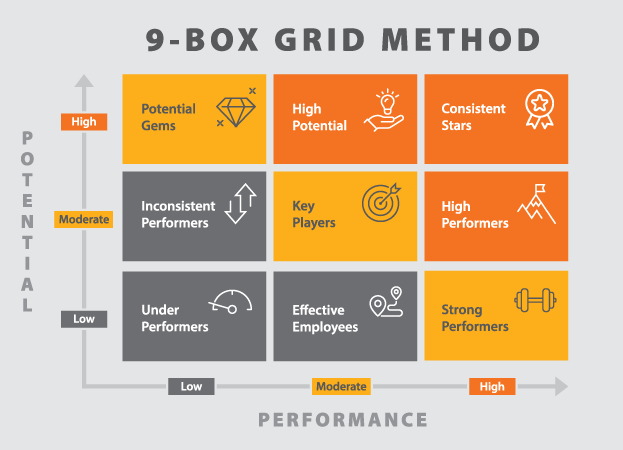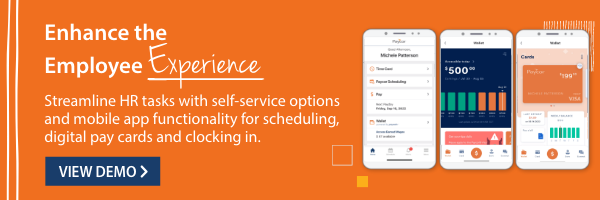In today’s competitive business environment, talent management is crucial for organizational success. As companies strive to identify, develop, and retain their top talent, coaching has emerged as a powerful tool for fostering employee growth and maximizing potential. Enter the 9-Box method—a proven and versatile approach that has transformed coaching in the workplace.
The 9-Box Method: Understanding the Grid and Its Dimensions
At the heart of the 9-Box method is a simple yet powerful grid that helps leaders assess and categorize employees based on two critical dimensions: performance and potential. The grid is made up of nine boxes in a 3×3 grid, with the vertical axis representing an employee’s potential (low, medium, or high) and the horizontal axis indicating their performance (low, medium, or high). By plotting employees on this grid, managers can gain valuable insights into their workforce and create tailored development plans to nurture and grow their talent.
How the 9-Box Grid Facilitates Employee Growth
The 9-Box grid serves as a diagnostic tool that enables leaders to identify the unique development needs of their employees. By classifying employees into various categories based on their performance and potential, HR professionals and managers can craft targeted coaching strategies that address individual strengths and weaknesses, promote skill development, and ultimately drive improved performance across the board.

Assessing Employee Performance and Potential
Effective use of the 9-Box method begins with a thorough assessment of employee performance. This process entails evaluating employees against established performance metrics and benchmarks, such as sales targets, customer satisfaction scores, or project completion rates. To ensure a fair and accurate assessment, leaders should draw on multiple sources of performance data, including quantitative metrics, qualitative feedback, and input from peers, supervisors, and subordinates.
The second dimension of the 9-Box grid—employee potential—captures an individual’s capacity for growth and advancement within the organization. Assessing potential is inherently more subjective than measuring performance, but managers can use various indicators to gauge an employee’s potential, such as their ability to learn and adapt, leadership qualities, and ambition. Like performance assessments, potential evaluations should incorporate input from multiple sources to minimize bias and help ensure a well-rounded perspective.
The Importance of Calibration: Ensuring Objective Assessments
To maximize the effectiveness of the 9-Box method, it’s important to calibrate performance and potential assessments. Calibration involves comparing and adjusting employee evaluations to ensure consistency and objectivity across the organization. By standardizing assessment criteria and promoting open dialogue among stakeholders, organizations can minimize subjective biases and foster a fair and transparent talent management process.
Addressing Employee Needs: Strategies for Each Box
With employees plotted on the 9-Box grid, you can begin crafting targeted development plans that address the unique needs of each employee category. For instance, high-potential employees with strong performance may benefit from opportunities to expand their leadership skills, while underperforming employees with low potential might require performance improvement plans (PIPs) or reassignment to more suitable roles. By tailoring coaching strategies to address individual strengths and weaknesses, organizations can optimize employee development and maximize their return on investment in coaching.
The Power of Individualized Coaching
It’s impossible to overstate the power of individualized coaching. When employees receive personalized guidance and support that aligns with their unique needs and goals, they are more likely to feel valued, engaged, and motivated to improve. By using the insights gleaned from the 9-Box grid, HR professionals and managers can offer targeted coaching that empowers employees to reach their full potential, ultimately driving better results for both the individual and the organization.
Preparing for Success: Setting the Stage for Effective Coaching
To successfully implement the 9-Box method, organizations must first lay a strong foundation. This includes establishing clear performance metrics and benchmarks, setting up a process for regular performance reviews, and fostering a culture that values employee development and growth. By creating an environment that supports and encourages coaching, organizations can maximize the impact of the 9-Box method on employee performance and potential.
Collaboration and Communication: Involving the Right Stakeholders
Effective implementation of the 9-Box method requires collaboration and communication among key stakeholders, including HR, managers, teammates, and employees themselves. By involving all relevant parties in the performance assessment, potential evaluation, and coaching processes, organizations can ensure that everyone is on the same page and working towards the same goals. Open and transparent communication is critical to fostering trust and buy-in from employees, who are more likely to be receptive to coaching and development efforts when they feel included and heard.
Establishing a Feedback Loop: Monitoring Progress and Adapting Plans
Regular monitoring and feedback are essential to the success of any coaching initiative, including the 9-Box method. By establishing a feedback loop that involves ongoing performance reviews, progress check-ins, and opportunities for employees to share their thoughts and concerns, leaders can fine-tune their coaching strategies and make necessary adjustments to better support employee growth. This iterative approach not only helps ensure that coaching efforts stay effective but also demonstrates a commitment to continuous improvement and employee development.
Common Pitfalls of the 9-Box Method and How to Avoid Them
While the 9-Box method is a powerful coaching tool, it’s essential to be mindful of potential pitfalls that can undermine its effectiveness. Some common mistakes to avoid include:
- Relying solely on quantitative metrics or subjective opinions when assessing performance and potential. Instead, use a balanced mix of data sources and input from multiple stakeholders. In addition to quantitative indicators, prioritize qualitative research as it is equally important.
- Focusing solely on high-potential employees at the expense of others. While high-potential employees are undoubtedly valuable, all employees can benefit from targeted coaching and development efforts.
- Neglecting to calibrate assessments, leading to inconsistencies and biases in employee evaluations. Regular calibration meetings can result in fair and objective assessments across the organization.
- Failing to communicate the purpose and benefits of the 9-Box method to employees, leading to confusion and resistance. Be transparent about the process and emphasize its value in promoting employee growth and development.
The Bigger Picture: Integrating the 9-Box Method into Your Talent Management Strategy
Aligning Coaching with Organizational Goals and Values
The 9-Box method shouldn’t be viewed as a standalone solution but rather as a critical component of a comprehensive talent management strategy. By aligning coaching efforts with broader organizational goals and values, HR professionals and managers can ensure that employee development initiatives support the company’s mission and contribute to long-term success. This holistic approach to talent management not only optimizes individual employee performance but also fosters a high-performance workforce that drives organizational growth and competitiveness.
Embracing the 9-Box Method for Long-Term Employee Development Success
The 9-Box method is a powerful coaching tool that can transform the way organizations identify, develop, and retain top talent. By providing a systematic framework for assessing employee performance and potential, the 9-Box method enables leaders to craft tailored development plans that address individual strengths and weaknesses, ultimately driving improved performance across the organization.
To successfully implement the 9-Box method, organizations must invest in the necessary groundwork, including establishing clear performance metrics, fostering a culture of employee development, and ensuring collaboration and communication among key stakeholders. Regular monitoring and feedback are essential to fine-tuning coaching strategies and adapting to employee needs as they evolve.
By embracing the 9-Box method and integrating it into a broader talent management strategy, organizations can unlock the full potential of their workforce, creating a high-performance culture that supports long-term growth and success. The journey to employee development success starts with understanding and mastering the 9-Box method. With this comprehensive guide in hand, HR professionals and managers will be well-equipped to harness the power of coaching and propel their organizations to new heights.
How Paycor Helps
Paycor’s talent development software moves beyond the annual performance review by allowing you to create a culture built on continuous feedback. Our low-touch, robust solution automates the entire talent development process. Paycor’s Career Management software includes 9-Box functionality to help leaders visualize individual employee performance and develop coaching strategies so they can better achieve their potential.










